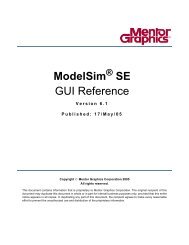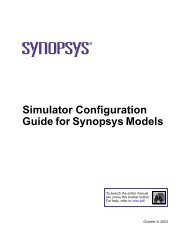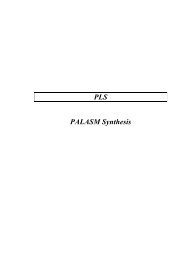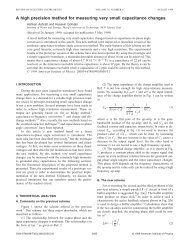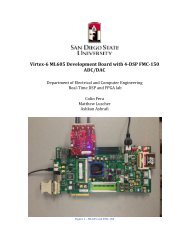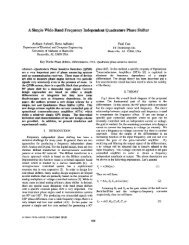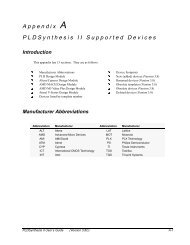On the SFDR Upperbound in DDFS Utilizing Polynomial ...
On the SFDR Upperbound in DDFS Utilizing Polynomial ...
On the SFDR Upperbound in DDFS Utilizing Polynomial ...
Create successful ePaper yourself
Turn your PDF publications into a flip-book with our unique Google optimized e-Paper software.
IEEE TRANSACTIONS ON CIRCUITS AND SYSTEMS—II: EXPRESS BRIEFS, VOL. 59, NO. 5, MAY 2012 307<strong>On</strong> <strong>the</strong> <strong>SFDR</strong> <strong>Upperbound</strong> <strong>in</strong> <strong>DDFS</strong> Utiliz<strong>in</strong>g<strong>Polynomial</strong> Interpolation MethodsAshkan Ashrafi, Senior Member, IEEEAbstract—In this brief, <strong>the</strong> <strong>the</strong>oretical analysis that obta<strong>in</strong>s<strong>the</strong> upperbound of <strong>the</strong> spurious free dynamic range (<strong>SFDR</strong>) of<strong>the</strong> direct digital frequency syn<strong>the</strong>sizers (<strong>DDFS</strong>s) with phaseto-s<strong>in</strong>emapper (PSM) structured by polynomial <strong>in</strong>terpolation isrevisited. A complete analysis of <strong>the</strong> <strong>SFDR</strong> upperbound of <strong>the</strong>se<strong>DDFS</strong> architectures was provided by Ashrafi and Adhami <strong>in</strong>2007, where <strong>the</strong> authors formulated <strong>the</strong> <strong>SFDR</strong> upperbound as<strong>the</strong> Chebyshev m<strong>in</strong>imax solution to an overdeterm<strong>in</strong>ed system ofl<strong>in</strong>ear equations. However, some issues <strong>in</strong> f<strong>in</strong>d<strong>in</strong>g <strong>the</strong> Chebyshevm<strong>in</strong>imax solution were not made clear <strong>in</strong> that paper regard<strong>in</strong>g <strong>the</strong>m<strong>in</strong>imax error at <strong>the</strong> fundamental harmonic of <strong>the</strong> output s<strong>in</strong>usoid.These issues, along with <strong>the</strong> erroneous behavior of numericalcomputation packages used for solv<strong>in</strong>g <strong>the</strong> Chebyshev m<strong>in</strong>imaxproblem, misled Chau and Chen to claim that <strong>the</strong> results of <strong>the</strong>aforementioned paper were wrong. This brief clarifies <strong>the</strong> issueswith <strong>the</strong> orig<strong>in</strong>al paper, exhibits <strong>the</strong> problems with some of <strong>the</strong>available numerical computation packages, and refutes <strong>the</strong> claimsthat Chau and Chen made.Index Terms—Chebyshev m<strong>in</strong>imax approximation, direct digitalfrequency syn<strong>the</strong>sizers (<strong>DDFS</strong>s), spurious free dynamic range(<strong>SFDR</strong>).I. INTRODUCTIONSPURIOUS free dynamic range (<strong>SFDR</strong>) <strong>in</strong> a direct digitalfrequency syn<strong>the</strong>sizer (<strong>DDFS</strong>) is <strong>the</strong> parameter that describes<strong>the</strong> spectral purity of <strong>the</strong> output s<strong>in</strong>usoidal signal. The<strong>SFDR</strong> is def<strong>in</strong>ed as <strong>the</strong> ratio of <strong>the</strong> magnitude of <strong>the</strong> fundamentalharmonic and <strong>the</strong> magnitude of <strong>the</strong> maximum spur of<strong>the</strong> output signal. The <strong>DDFS</strong> systems comprise an accumulator,phase-to-s<strong>in</strong>e mapper (PSM), and digital-to-analog converter.The frequency of <strong>the</strong> s<strong>in</strong>e output is controlled by a digital <strong>in</strong>putnumber F rf out = F r2 L f clk (1)where F r , L, and f clk are <strong>the</strong> <strong>in</strong>put of <strong>the</strong> accumulator, <strong>the</strong>accumulator wordlength, and <strong>the</strong> clock frequency, respectively[1]. The PSM could be as simple as a lookup table or ascomplex as a Coord<strong>in</strong>ate Rotation Digital Computer (CORDIC)system [2]. Piecewise polynomial <strong>in</strong>terpolation methods arealso used to approximate <strong>the</strong> s<strong>in</strong>e signal by polynomials [3]–[6]. In this method, <strong>the</strong> first quadrant of <strong>the</strong> s<strong>in</strong>usoid is divided<strong>in</strong>to s =2 u segments, and each segment is approximated byManuscript received November 10, 2011; revised January 14, 2012; acceptedFebruary 25, 2012. Date of publication April 13, 2012; date of current versionMay 16, 2012. This paper was recommended by Associate Editor A. Brambilla.The author is with <strong>the</strong> Department of Electrical and Computer Eng<strong>in</strong>eer<strong>in</strong>g,San Diego State University, San Diego, CA 92182 USA (e-mail: ashrafi@mail.sdsu.edu).Digital Object Identifier 10.1109/TCSII.2012.2190861a polynomial. Therefore, <strong>the</strong> output can be reconstructed byadditions and multiplications of <strong>the</strong> phase signal (<strong>the</strong> accumulatoroutput) along with <strong>the</strong> format conversion that generates <strong>the</strong>o<strong>the</strong>r quadrants of <strong>the</strong> s<strong>in</strong>usoid. The sequence that is producedby <strong>the</strong> PSM is called <strong>the</strong> signature sequence [7].Consider<strong>in</strong>g <strong>in</strong>f<strong>in</strong>ite output wordlength, <strong>the</strong>re are two sourcesfor <strong>the</strong> output s<strong>in</strong>usoid spur harmonics. The first source is <strong>the</strong>phase truncation, which is necessary to reduce <strong>the</strong> hardwarecomplexity of <strong>the</strong> PSM. The effect of <strong>the</strong> phase truncation on<strong>the</strong> <strong>SFDR</strong> is thoroughly studied <strong>in</strong> [7] and [8]. The secondsource of <strong>the</strong> output s<strong>in</strong>usoid spur harmonics is <strong>the</strong> nonidealities<strong>in</strong> <strong>the</strong> PSM that create an error <strong>in</strong> <strong>the</strong> signature sequence.It has been shown that <strong>the</strong> spur magnitudes and locationscaused by <strong>the</strong> phase truncation and nonidealities of <strong>the</strong> PSMare disjo<strong>in</strong>t [7]. Therefore, by know<strong>in</strong>g <strong>the</strong> spectrum of <strong>the</strong>signature sequence, one can exactly determ<strong>in</strong>e <strong>the</strong> magnitudesand locations of <strong>the</strong> spur harmonics at <strong>the</strong> s<strong>in</strong>e output of <strong>the</strong><strong>DDFS</strong>.The ma<strong>in</strong> goal <strong>in</strong> design<strong>in</strong>g <strong>DDFS</strong> systems is to reduce <strong>the</strong>size and power of <strong>the</strong> f<strong>in</strong>al chip. This goal can be reached bymodify<strong>in</strong>g <strong>the</strong> architecture of <strong>the</strong> PSM that results <strong>in</strong> higherspur harmonics and lower <strong>SFDR</strong>. Therefore, we should strike abalance <strong>in</strong> <strong>the</strong> hardware complexity and <strong>the</strong> <strong>SFDR</strong> of <strong>the</strong> <strong>DDFS</strong>.To be able to do so, <strong>the</strong> <strong>the</strong>oretical upperbound of <strong>the</strong> <strong>SFDR</strong>should be known for <strong>the</strong> desired s<strong>in</strong>e approximation method.The <strong>SFDR</strong> upperbound can provide a mean<strong>in</strong>gful criterionto stop <strong>the</strong> optimization algorithm targeted at achiev<strong>in</strong>g <strong>the</strong>highest <strong>SFDR</strong> for <strong>the</strong> desired hardware complexity. A comprehensivestudy of <strong>the</strong> <strong>SFDR</strong> upperbound for <strong>the</strong> polynomial<strong>in</strong>terpolation methods is given <strong>in</strong> [9] where <strong>the</strong> <strong>SFDR</strong> upperboundwas found as <strong>the</strong> Chebyshev m<strong>in</strong>imax solution to anoverdeterm<strong>in</strong>ed system of equations.Although <strong>the</strong> method given <strong>in</strong> [9] is a universal method off<strong>in</strong>d<strong>in</strong>g <strong>the</strong> <strong>SFDR</strong> upperbound for any polynomial <strong>in</strong>terpolationbased <strong>DDFS</strong>, it highly depends on <strong>the</strong> optimization algorithmemployed to f<strong>in</strong>d <strong>the</strong> Chebyshev m<strong>in</strong>imax solution of <strong>the</strong>overdeterm<strong>in</strong>ed system of equations. Unfortunately, some of<strong>the</strong> available optimization packages do not provide a correctanswer and may lead to an <strong>in</strong>correct <strong>SFDR</strong> upperbound. Thiserroneous behavior usually happens at <strong>the</strong> m<strong>in</strong>imax error valuesof <strong>the</strong> solution, particularly at <strong>the</strong> m<strong>in</strong>imax error value of <strong>the</strong>first harmonic. Unfortunately, Chau and Chen [10] used <strong>the</strong><strong>in</strong>correct results of <strong>the</strong>ir numerical calculations and challenged<strong>the</strong> results of [9]. In this brief, a few issues that rema<strong>in</strong>edunclear <strong>in</strong> [9] (<strong>in</strong>clud<strong>in</strong>g <strong>the</strong> fact that one of <strong>the</strong> m<strong>in</strong>imax errorvalues always occurs at <strong>the</strong> first harmonic of <strong>the</strong> spectrum of <strong>the</strong><strong>DDFS</strong> output and it is always a positive number) are addressed,and based on <strong>the</strong>m, <strong>the</strong> results of [10] are refuted.1549-7747/$31.00 © 2012 IEEE
308 IEEE TRANSACTIONS ON CIRCUITS AND SYSTEMS—II: EXPRESS BRIEFS, VOL. 59, NO. 5, MAY 2012The rest of <strong>the</strong> brief is organized as follows. In Section II,<strong>the</strong> <strong>the</strong>oretical upperbound of <strong>the</strong> <strong>SFDR</strong> is revisited, and itis proved that <strong>the</strong> first m<strong>in</strong>imax error value always occurs at<strong>the</strong> first harmonic. In Section III, different computer packagesare used to f<strong>in</strong>d <strong>the</strong> <strong>SFDR</strong> upperbound. It is shown that mostof <strong>the</strong> computer packages have difficulties f<strong>in</strong>d<strong>in</strong>g <strong>the</strong> correctm<strong>in</strong>imax solution and <strong>the</strong> <strong>SFDR</strong> upperbound. In Section IV,<strong>the</strong> <strong>SFDR</strong> upperbound of <strong>the</strong> <strong>DDFS</strong> based on <strong>the</strong> distressedeven polynomials (DEPs) is calculated for different polynomialorders. In Section V, we discuss <strong>the</strong> results and show that <strong>the</strong>ycontradict <strong>the</strong> results obta<strong>in</strong>ed <strong>in</strong> [10], which concludes that <strong>the</strong>results <strong>in</strong> [10] are <strong>in</strong>correct. In Section VI, <strong>the</strong> conclusions aredrawn.II. REVISITING THE THEORETICAL UPPERBOUNDOF THE <strong>SFDR</strong>Consider that <strong>the</strong> first quadrant of <strong>the</strong> s<strong>in</strong>usoidal signal( π)f(x) =s<strong>in</strong>2 x , 0 ≤ x ≤ 1 (2)is divided <strong>in</strong>to s =2 u segments and each segment is approximatedby a polynomial P k (x) of order d, such thatP k (x) =d∑i=0c (k)i (x − x k ) i ,x k ≤ x ≤ x k+1 ; k =1,...,s (3)where x represents <strong>the</strong> phase of <strong>the</strong> <strong>DDFS</strong> (truncated output of<strong>the</strong> accumulator); c (k)i is <strong>the</strong> ith coefficient of <strong>the</strong> polynomial,which <strong>in</strong>terpolates <strong>the</strong> kth segment x k ≤ x ≤ x k+1 ; and x k =(k − 1)/s is <strong>the</strong> start<strong>in</strong>g po<strong>in</strong>t of <strong>the</strong> kth segment. To f<strong>in</strong>d<strong>the</strong> spectrum of <strong>the</strong> entire signal, <strong>the</strong> Fourier series can beemployed. Because of <strong>the</strong> quadrature wave symmetry, <strong>the</strong> evenharmonics are zero, and <strong>the</strong> odd coefficients are obta<strong>in</strong>ed byb n =2∫ 10( nπ)P (x)s<strong>in</strong>2 x dx. (4)By substitut<strong>in</strong>g (3) <strong>in</strong>to (4), one can obta<strong>in</strong>s∑ d∑b n = a (k)ni c(k) i (5)whereBy def<strong>in</strong><strong>in</strong>g(c k =a (k)ni =2c (k)i)c k ∈ R (d+1)×1∫x k+1x k(A k =k=1 i=0(x − x k ) i s<strong>in</strong>a (k)ni)A k ∈ R N×(d+1)( nπ2 x )dx. (6)1 ≤ k ≤ s 0 ≤ i ≤ d n =1, 3,...,2N − 1A =[A 1 |A 2 |A 3 |···|A s−1 |A s ] A ∈ R N×(d+1)sz = [ c T 1 |c T 2 |c T 3 |···|c T s−1|c T ] Ts z ∈ R (d+1)s×1 (7)one can represent (5) <strong>in</strong> <strong>the</strong> matrix form ofb = Az (8)where b ∈ R N×1 is a vector conta<strong>in</strong><strong>in</strong>g <strong>the</strong> harmonic values of<strong>the</strong> output signal. For more calculation details, please see [9].<strong>On</strong>e can use (8) as an equation <strong>in</strong> which <strong>the</strong> entries of <strong>the</strong> vectorb are predef<strong>in</strong>ed. The desired values of <strong>the</strong> entries of <strong>the</strong> vectorb areb ′ =[1 0 ··· 0] T , b ′ ∈ R N×1 (9)because we would like to have an ideal s<strong>in</strong>usoid (only <strong>the</strong>fundamental harmonic is nonzero). Therefore, <strong>the</strong> problem canbe simplified as <strong>the</strong> solution to <strong>the</strong> follow<strong>in</strong>g matrix equation:Az = b ′ . (10)It should be mentioned that N>(d +1)s,asitisshown<strong>in</strong>[9];thus, (10) is an overdeterm<strong>in</strong>ed matrix equation.The matrix equation (10) does not have any solution. Anapproximate solution that m<strong>in</strong>imizes <strong>the</strong> <strong>in</strong>f<strong>in</strong>ity norm of <strong>the</strong>error (‖η(z)‖ ∞ = ‖b ′ − Az‖ ∞ ) can be found, where η(z) =b ′ − Az is called <strong>the</strong> error vector. This solution is called <strong>the</strong>Chebyshev m<strong>in</strong>imax solution [11]. By def<strong>in</strong><strong>in</strong>g <strong>the</strong> positive realparameter ρ as <strong>the</strong> upperbound of <strong>the</strong> error vector |η(ẑ)| =|b ′ − Az|, one can express <strong>the</strong> problem as m<strong>in</strong>imiz<strong>in</strong>g <strong>the</strong> valueof ρ such that|b ′ − Az| ρ. (11)This <strong>in</strong>equality can be divided <strong>in</strong>to two <strong>in</strong>equalitiesρ + Az b ′ρ − Az − b ′ .(12a)(12b)The only parameter <strong>in</strong> (12) that needs to be m<strong>in</strong>imized is ρ;thus, (12) can be posed as a l<strong>in</strong>ear programm<strong>in</strong>g (LP) problemdef<strong>in</strong>ed as follows:m<strong>in</strong>imizeρsubject to[ ]zvρ[+A 1N×1−A][ ] [ ]z b′1 N×1 ρ −b(13)where v =[0 (d+1) s 1].If <strong>the</strong> solution to (13) is ˜z (that m<strong>in</strong>imizes <strong>the</strong> norm‖η(z)‖ ∞ = ‖b ′ − Az‖ ∞ ), <strong>the</strong>n accord<strong>in</strong>g to [9, Th. 1], <strong>the</strong>associated magnitude error vector |η(˜z)| = |b − A˜z| has, atmost, N +1 components (m<strong>in</strong>imax) equal to <strong>the</strong> m<strong>in</strong>imizednorm ˜ρ = ‖η(˜z)‖ ∞ . It is also shown <strong>in</strong> [9] that if <strong>the</strong> matrixA is a Haar matrix, <strong>the</strong> solution ˜z is unique, and <strong>the</strong>re areexactly N +1m<strong>in</strong>imax values <strong>in</strong> <strong>the</strong> error vector. O<strong>the</strong>rwise,<strong>the</strong> problem has <strong>in</strong>f<strong>in</strong>ite solutions, and one of <strong>the</strong>m is associatedto <strong>the</strong> error vector with N +1 m<strong>in</strong>imax error values (see [9,Fig. 3]). We call this solution <strong>the</strong> reference solution ˜z r .Itisworth not<strong>in</strong>g that an n × m matrix (n >m) is a Haar matrixwhen all of its m × m submatrices are full rank. The referencesolution can be obta<strong>in</strong>ed us<strong>in</strong>g <strong>the</strong> simplex algorithm, andit is employed to def<strong>in</strong>e <strong>the</strong> reference matrix, which can beused to f<strong>in</strong>d <strong>the</strong> solution associated to <strong>the</strong> sparsest error vector(see [9, Fig. 4]). We call this solution <strong>the</strong> strict solution ˜z s .
ASHRAFI: ON THE <strong>SFDR</strong> UPPERBOUND IN <strong>DDFS</strong> UTILIZING POLYNOMIAL INTERPOLATION METHODS 309It is also shown that <strong>the</strong> first m<strong>in</strong>imax error value occursat <strong>the</strong> first harmonic; thus, <strong>the</strong> <strong>SFDR</strong> upperbound can becalculated by<strong>SFDR</strong> upperbound = 1 − ˜ρ˜ρ . (14)The aforementioned analysis was supported by empirical data,and it was never proved <strong>in</strong> [9]. To prove that <strong>the</strong> first m<strong>in</strong>imaxerror value occurs at <strong>the</strong> first harmonic, we can use <strong>the</strong> dual LPproblem associated to (13)maximizewsubject to[+b T − b T ]w[ ] [ ]11×N 1 1×N1+A T −A T w = ,0 (d+1)sw ≥ 0 (15)where w ∈ R 2N×1 . It has been proved that <strong>the</strong> solution to(15) ˜w has at most N +1nonzero entries [12]. If <strong>the</strong> matrix Ais a Haar matrix, <strong>the</strong>n <strong>the</strong>re are exactly N +1nonzero entries<strong>in</strong> ˜w. The nonzero entries of ˜w can be used to f<strong>in</strong>d <strong>the</strong> strictsolution [12]. Moreover, it is also shown that <strong>the</strong> entries of˜w correspond<strong>in</strong>g to strict <strong>in</strong>equalities <strong>in</strong> <strong>the</strong> LP (13) are zero[12]. Let ˜w =[p T |q T ] T , where p, q ∈ R N×1 .If<strong>the</strong>ith entryof q (q i ) is nonzero, <strong>the</strong>n <strong>the</strong> ith entry of p (p i ) is def<strong>in</strong>itelyzero ([13, Lemma 4.3]). S<strong>in</strong>ce p corresponds to A <strong>in</strong> (13) andq corresponds to −A <strong>in</strong> (13), thus, <strong>the</strong> vector u =(p − q)provides <strong>the</strong> exact locations of <strong>the</strong> m<strong>in</strong>imax values, and <strong>the</strong>signs of <strong>the</strong> entries of u are <strong>the</strong> signs of <strong>the</strong>ir correspond<strong>in</strong>gm<strong>in</strong>imax components <strong>in</strong> <strong>the</strong> error vector associated to <strong>the</strong> strictsolution ˜z s .It is well known that when both <strong>the</strong> l<strong>in</strong>ear program (13) andits dual (15) have optimized solutions, <strong>the</strong>ir objective functionsare equal [14], i.e.,[˜z˜ρ]v =[+b T − b T ] ˜w. (16)Accord<strong>in</strong>g to <strong>the</strong> def<strong>in</strong>itions of v, b, w, p, and q, we cansimplify (16) to˜ρ = p 1 − q 1 . (17)We know that ˜ρ >0 and ˜w ≥ 0. Thus, p 1 ≥ 0, and q 1 ≥ 0.<strong>On</strong> <strong>the</strong> o<strong>the</strong>r hand, ei<strong>the</strong>r p 1 =0or q 1 =0. Therefore, it canbe easily seen that q 1 =0because both sides of (17) shouldbe positive. This means that <strong>the</strong> first m<strong>in</strong>imax value occursat <strong>the</strong> first harmonic, and its value is positive. Therefore,η 1 (˜z) =b 1 − a 1˜z =˜ρ, where a 1 is <strong>the</strong> first row of <strong>the</strong> matrixA. Know<strong>in</strong>g <strong>the</strong> fact that b 1 =1, we can conclude that <strong>the</strong>magnitude of <strong>the</strong> first harmonic of <strong>the</strong> output signal is 1 − ˜ρ,and thus, <strong>the</strong> <strong>SFDR</strong> upperbound can be obta<strong>in</strong>ed by (14).If <strong>the</strong> algorithm utilized to solve <strong>the</strong> LP problem (13) doesnot converge to <strong>the</strong> correct solution, <strong>the</strong> <strong>SFDR</strong> upperboundobta<strong>in</strong>ed by (14) will be wrong. The behaviors of several optimizationpackages are <strong>in</strong>vestigated <strong>in</strong> <strong>the</strong> next section, and itis shown that some of <strong>the</strong>m cannot be trusted when a Chebyshevm<strong>in</strong>imax solution of an overdeterm<strong>in</strong>ed system of equations issought.Fig. 1. Inconsistencies between <strong>the</strong> error vectors of <strong>the</strong> output of a <strong>DDFS</strong> withs =8and d =3obta<strong>in</strong>ed with different packages.TABLE ICOMPARISON BETWEEN THE FIRST MINIMAX ERROR(×10 −6 ) OBTAINED BY DIFFERENT PACKAGESIII. NUMERICAL COMPUTATIONSF<strong>in</strong>d<strong>in</strong>g <strong>the</strong> <strong>SFDR</strong> upperbound of <strong>the</strong> output of a polynomialbased<strong>DDFS</strong> architecture is not straightforward. The <strong>SFDR</strong>depends on <strong>the</strong> m<strong>in</strong>imax errors, and <strong>the</strong>y are usually smallnumbers. Thus, high-accuracy algorithms are required. Mistakescould be easily made <strong>in</strong> f<strong>in</strong>d<strong>in</strong>g <strong>the</strong> <strong>SFDR</strong> upperbound(for example, see [15] and [16]). These mistakes can be mislead<strong>in</strong>gand, if not verified with ma<strong>the</strong>matical facts, will lead to<strong>in</strong>correct conclusions. We have used several numerical analysispackages to solve <strong>the</strong> LP problem (13). These packages areMATLAB LP algorithm, IBM CPLEX Studio, MOSEK, andCVX that uses SeDuMi and SDPT3 eng<strong>in</strong>es [17].Fig. 1 illustrates <strong>the</strong> <strong>in</strong>consistencies between different methodsof solv<strong>in</strong>g <strong>the</strong> LP problem. The goal was to f<strong>in</strong>d <strong>the</strong> strictsolution to <strong>the</strong> problem. Although <strong>the</strong> <strong>in</strong>consistencies exist forall m<strong>in</strong>imax error values, it is more significant for <strong>the</strong> firstm<strong>in</strong>imax error that occurs at <strong>the</strong> first harmonic. Table I shows<strong>the</strong> magnitudes of <strong>the</strong> first m<strong>in</strong>imax error values obta<strong>in</strong>ed by <strong>the</strong>aforementioned packages for d =2and different values of s.It can be seen from <strong>the</strong> table that <strong>the</strong> LP methods provide <strong>the</strong>best results. However, <strong>the</strong> IBM CPLEX package showed to bemore accurate than MATLAB and MOSEK. It should be notedthat <strong>the</strong> LP problem (13) is degenerate because of <strong>the</strong> fact that<strong>the</strong> matrix A is not a Haar matrix [13]. This degeneracy may be<strong>the</strong> cause of <strong>the</strong> <strong>in</strong>consistencies between different packages.
310 IEEE TRANSACTIONS ON CIRCUITS AND SYSTEMS—II: EXPRESS BRIEFS, VOL. 59, NO. 5, MAY 2012Fig. 2. Error vector of <strong>the</strong> <strong>DDFS</strong> output based on <strong>the</strong> DEP <strong>in</strong>terpolation for different polynomial degrees m.TABLE II<strong>SFDR</strong> UPPERBOUNDS AND THEIR CORRESPONDING COEFFICIENTS FOR THE <strong>DDFS</strong> BASED ON THE DISTRESSED EVEN POLYNOMIALSIn [10], <strong>the</strong> first harmonic is fixed to <strong>the</strong> unity by <strong>in</strong>clud<strong>in</strong>ga l<strong>in</strong>ear equality constra<strong>in</strong>t to <strong>the</strong> LP problem (13). This willtake care of <strong>the</strong> <strong>in</strong>consistency regard<strong>in</strong>g <strong>the</strong> first harmonic.However, it cannot solve <strong>the</strong> problem of o<strong>the</strong>r <strong>in</strong>consistencieswhich arise with <strong>the</strong> o<strong>the</strong>r m<strong>in</strong>imax error values because <strong>the</strong>se<strong>in</strong>consistencies are caused by <strong>the</strong> fact that <strong>the</strong> matrix A is nota Haar matrix. The added l<strong>in</strong>ear equality constra<strong>in</strong>t just reduces<strong>the</strong> order of <strong>the</strong> reference matrix by one. <strong>On</strong> <strong>the</strong> o<strong>the</strong>r hand,this constra<strong>in</strong>t pushes up <strong>the</strong> o<strong>the</strong>r spurs <strong>in</strong> such a way that<strong>the</strong> <strong>SFDR</strong> upperbound will rema<strong>in</strong> <strong>the</strong> same. Therefore, nomean<strong>in</strong>gful benefit can be ga<strong>in</strong>ed by add<strong>in</strong>g this constra<strong>in</strong>t.IV. <strong>SFDR</strong> OF THE <strong>DDFS</strong> ARCHITECTURESBASED ON THE DEPS<strong>On</strong>e way to avoid segmentation of <strong>the</strong> first quadrant of <strong>the</strong>s<strong>in</strong>usoidal signal is us<strong>in</strong>g <strong>the</strong> DEPs of order mD(x) =c 0 + c 2 x 2 + c 4 x 4 + c 6 x 6 + ...+ c 2m x 2m . (18)Utiliz<strong>in</strong>g <strong>the</strong> DEP of order 2 is thoroughly studied <strong>in</strong> [9] and[18]. In [10], <strong>the</strong> <strong>SFDR</strong> upperbounds and <strong>the</strong>ir correspond<strong>in</strong>goptimum coefficients are found, but <strong>the</strong> results are <strong>in</strong>correct.To have <strong>the</strong> correct <strong>SFDR</strong> upperbounds and <strong>the</strong>ir correspond<strong>in</strong>gcoefficients, we have solved <strong>the</strong> LP problem (13) for <strong>the</strong>polynomial configuration of (18). The matrix A <strong>in</strong> this problemis a Haar matrix; thus, <strong>the</strong> Chebyshev m<strong>in</strong>imax solution isunique and can be easily calculated by <strong>the</strong> simplex algorithm.Fig. 2 shows <strong>the</strong> error vectors and <strong>the</strong> m<strong>in</strong>imax values of <strong>the</strong><strong>DDFS</strong> designed based on <strong>the</strong> DEPs of orders 1, 2, 3, and 4.Table II shows <strong>the</strong> <strong>SFDR</strong>s, <strong>the</strong> correspond<strong>in</strong>g coefficients, and<strong>the</strong> values of ˜ρ for <strong>the</strong> DEPs of orders 1, 2, 3, and 4. It shouldbe noted that <strong>the</strong> values of ˜ρ are all positive, which affirms <strong>the</strong>ma<strong>the</strong>matical argument given <strong>in</strong> Section III.V. D ISCUSSIONIn <strong>the</strong> previous sections, it is ma<strong>the</strong>matically proved that<strong>the</strong> first m<strong>in</strong>imax error value correspond<strong>in</strong>g to <strong>the</strong> coefficientsthat give <strong>the</strong> <strong>SFDR</strong> upperbound always occurs at <strong>the</strong> firstharmonic. The conclusions drawn <strong>in</strong> [10] are entirely based on<strong>the</strong> <strong>in</strong>correct assumption that <strong>the</strong> error of <strong>the</strong> first harmonic isdifferent than <strong>the</strong> m<strong>in</strong>imax error. To show <strong>the</strong> discrepancies <strong>in</strong>[10], one can compare <strong>the</strong> <strong>SFDR</strong> upperbound obta<strong>in</strong>ed <strong>in</strong> [10]for <strong>the</strong> fourth-order DEP (155.38 dBc) and <strong>the</strong> one obta<strong>in</strong>edhere and shown <strong>in</strong> Table I for <strong>the</strong> same polynomial <strong>in</strong>terpolation(158.14 dBc), which is obviously higher. In addition, one canclearly see that <strong>the</strong> coefficients of <strong>the</strong> DEPs are <strong>in</strong>correctly
ASHRAFI: ON THE <strong>SFDR</strong> UPPERBOUND IN <strong>DDFS</strong> UTILIZING POLYNOMIAL INTERPOLATION METHODS 311obta<strong>in</strong>ed <strong>in</strong> [10] (see [10, Table II]) by compar<strong>in</strong>g <strong>the</strong>m to <strong>the</strong>coefficients given <strong>in</strong> Table II of this brief. Moreover, [10, Fig. 3]clearly illustrates that <strong>the</strong> <strong>SFDR</strong> upperbounds obta<strong>in</strong>ed <strong>in</strong> [9]are less than 0.1% smaller that <strong>the</strong> ones obta<strong>in</strong>ed <strong>in</strong> [10]for polynomial <strong>in</strong>terpolations of different orders. These smalldifferences fall <strong>in</strong> <strong>the</strong> numerical computation error range, yet<strong>the</strong> authors <strong>in</strong> [10] argued that <strong>the</strong>ir method provides a better<strong>SFDR</strong> upperbound due to <strong>the</strong>se small differences.VI. CONCLUSIONF<strong>in</strong>d<strong>in</strong>g <strong>the</strong> <strong>SFDR</strong> upperbound of <strong>the</strong> <strong>DDFS</strong>s with architecturesbased on <strong>the</strong> polynomial <strong>in</strong>terpolation method hasbeen revisited <strong>in</strong> this brief. The Chebyshev m<strong>in</strong>imax solutionof <strong>the</strong> related overdeterm<strong>in</strong>ed l<strong>in</strong>ear equations determ<strong>in</strong>es <strong>the</strong><strong>SFDR</strong> upperbound. The Chebyshev m<strong>in</strong>imax problem can besolved by an LP problem. It has been shown that most of <strong>the</strong>available computer packages fail to solve this problem because<strong>the</strong> matrix of <strong>the</strong> equation is not a Haar matrix. This has ledo<strong>the</strong>r authors to <strong>in</strong>correctly deduce that <strong>the</strong> first m<strong>in</strong>imax errorvalue does not occur at <strong>the</strong> first harmonic. In this brief, it hasbeen ma<strong>the</strong>matically proved that <strong>the</strong> first m<strong>in</strong>imax error valuealways occurs at <strong>the</strong> first harmonic by us<strong>in</strong>g <strong>the</strong> dual of <strong>the</strong> LPproblem. This has been used to show that <strong>the</strong> results obta<strong>in</strong>ed byChau and Chen, where <strong>the</strong>y claimed that <strong>the</strong> first m<strong>in</strong>imax errorvalue does not occur at <strong>the</strong> first harmonic, are <strong>in</strong> fact <strong>in</strong>correct.This method has been also used to f<strong>in</strong>d <strong>the</strong> <strong>SFDR</strong> upperbound of<strong>the</strong> <strong>DDFS</strong> based on DEP <strong>in</strong>terpolation. A Comparison between<strong>the</strong> obta<strong>in</strong>ed <strong>SFDR</strong> upperbounds with those reported by Chauand Chen can clearly show <strong>the</strong> <strong>in</strong>correctness of <strong>the</strong> latter.REFERENCES[1] J. Vankka and K. Halonen, Direct Digital Syn<strong>the</strong>sizers, Theory, Designand Applications. Norwell, MA: Kluwer, 2001.[2] J. Vankka, “Methods of mapp<strong>in</strong>g from phase to s<strong>in</strong>e amplitude <strong>in</strong> directdigital syn<strong>the</strong>sis,” IEEE Trans. Ultrason., Ferroelect., Freq. Control,vol. 44, no. 2, pp. 526–534, Mar. 1997.[3] J. Langlois and D. Al-Khalili, “Novel approach to <strong>the</strong> design of directdigital frequency syn<strong>the</strong>sizers based on l<strong>in</strong>ear <strong>in</strong>terpolation,” IEEE Trans.Circuits Syst. II, Analog Digit. Signal Process., vol. 50, no. 9, pp. 567–578, Sep. 2003.[4] A. Ashrafi, R. Adhami, L. Jo<strong>in</strong>er, and P. Kaveh, “Arbitrary waveform<strong>DDFS</strong> utiliz<strong>in</strong>g Chebyshev polynomials <strong>in</strong>terpolation,” IEEE Trans.Circuits Syst. I, Reg. Papers, vol. 51, no. 8, pp. 1468–1475, Aug. 2004.[5] D. De Caro and A. Strollo, “High-performance direct digital frequencysyn<strong>the</strong>sizers us<strong>in</strong>g piecewise-polynomial approximation,” IEEE Trans.Circuits Syst. I, Reg. Papers, vol. 52, no. 2, pp. 324–337, Feb. 2005.[6] A. Ashrafi, R. Adhami, and A. Milenkovic, “A direct digital frequencysyn<strong>the</strong>sizer based on <strong>the</strong> quasi-l<strong>in</strong>ear <strong>in</strong>terpolation method,” IEEE Trans.Circuits Syst. I, Reg. Papers, vol. 57, no. 4, pp. 863–872, Apr. 2010.[7] A. Torosyan and A. Willson, “Exact analysis of DDS spurs and SNRdue to phase truncation and arbitrary phase-to-amplitude errors,” <strong>in</strong> Proc.IEEE Int. Freq. Control Symp. Expo., Aug. 2005, pp. 50–80.[8] F. Curticãpean and J. Niittylahti, “Exact analysis of spurious signals <strong>in</strong>direct digital frequency syn<strong>the</strong>sizers due to phase truncation,” Electron.Lett., vol. 39, no. 6, pp. 499–501, Mar. 2003.[9] A. Ashrafi and R. Adhami, “Theoretical upperbound of <strong>the</strong> spuriousfreedynamic range <strong>in</strong> direct digital frequency syn<strong>the</strong>sizers realized bypolynomial <strong>in</strong>terpolation methods,” IEEE Trans. Circuits Syst. I, Reg.Papers, vol. 54, no. 10, pp. 2252–2261, Oct. 2007.[10] Y. Chau and Y.-H. Chen, “A novel design approach for ROM-less directdigital frequency syn<strong>the</strong>sizers based on polynomial approximations,” <strong>in</strong>Proc. ISPACS 2008, Feb. 2009, pp. 1–4.[11] G. A. Wateson, “Approximation <strong>in</strong> normed l<strong>in</strong>ear spaces,” J. Comput.Appl. Math., vol. 121, no. 1/2, pp. 1–36, Sep. 2000.[12] R. H. Bartels, A. R. Conn, and C. Charalambous, “<strong>On</strong> Cl<strong>in</strong>e’s directmethod for solv<strong>in</strong>g overdeterm<strong>in</strong>ed l<strong>in</strong>ear systems <strong>in</strong> <strong>the</strong> l ∞ sense,” SIAMJ. Numer. Anal., vol. 15, no. 2, pp. 225–270, Apr. 1978.[13] M. R. Osborn and G. A. Watson, “<strong>On</strong> <strong>the</strong> best l<strong>in</strong>ear Chebyshev approximation,”Comput. J., vol. 10, no. 2, pp. 172–177, Aug. 1967.[14] D. G. Luenberger and Y. Ye, L<strong>in</strong>ear and Nonl<strong>in</strong>ear Programm<strong>in</strong>g,3rded.New York: Spr<strong>in</strong>ger-Verlag, 2008.[15] C.-C. Wang, Y.-L. Tseng, H.-C. She, C.-C. Li, and R. Hu, “A 13-bit resolutionROM-less direct digital frequency syn<strong>the</strong>sizer based on a trigonometricquadruple angle formula,” IEEE Trans. Very Large Scale Integr.(VLSI) Syst., vol. 12, no. 9, pp. 895–900, Sep. 2004.[16] A. Ashrafi and R. Adhami, “Comments on “A 13-bit resolution ROMlessdirect digital frequency syn<strong>the</strong>sizer based on a trigonometric quadrupleangle formula”,” IEEE Trans. Very Large Scale Integr. (VLSI) Syst.,vol. 13, no. 9, pp. 1096–1098, Sep. 2005.[17] M. Grant and S. Boyd, CVX: Matlab Software for Discipl<strong>in</strong>edConvex Programm<strong>in</strong>g, Version 1.21, Apr. 2011. [<strong>On</strong>l<strong>in</strong>e]. Available:http://cvxr.com/cvx[18] A. Ashrafi and R. Adhami, “An optimized direct digital frequency syn<strong>the</strong>sizerbased on even fourth order polynomial <strong>in</strong>terpolation,” <strong>in</strong> Proc. 38thSSST, Mar. 2006, pp. 109–113.



